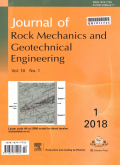- 钛学术文献服务平台 \
- 学术期刊 \
- 基础科学期刊 \
- 天文学、地球科学期刊 \
- 岩石力学与岩土工程学报(英文版)期刊 \
Uncertainties of thermal boundaries and soil properties on permafrost table of frozen ground in Qinghai-Tibet Plateau
Uncertainties of thermal boundaries and soil properties on permafrost table of frozen ground in Qinghai-Tibet Plateau
基本信息来源于合作网站,原文需代理用户跳转至来源网站获取
摘要:
In the permafrost regions of the Qinghai-Tibet Plateau (QTP), the permafrost table has a significant effect on the stability of geotechnical engineering. The thermal boundaries and soil properties are the key factors affecting the permafrost table. Complex geological environments and human activities can lead to the uncertainties of thermal boundaries and soil properties. In this paper, an array of field experiments and Monte Carlo (MC) simulations of thermal boundaries and soil properties are carried out. The coef-ficient of variation (COV), scale of fluctuation (SOF), and autocorrelation distance (ACD) of uncertainties of thermal boundaries and soil properties are investigated. A stochastic analysis method of the proba-bilistic permafrost table is then proposed, and the statistical properties of permafrost table on the QTP are computed by self-compiled program. The proposed stochastic analysis method is verified with the calculated and measured temperature observations. According to the relationship between ACD and SOF for the five theoretical autocorrelation functions (ACFs), the effects of ACF, COV, and ACD of soil prop-erties and the COV of thermal boundaries on the permafrost tables are analyzed. The results show that the effects of different ACFs of soil properties on the standard deviation (SD) of permafrost table depth are not obvious. The SD of permafrost table depth increases with time, and the larger the COVs of thermal boundaries and soil properties, the deeper the SD of permafrost table; the longer the ACD of soil properties, the shallower the SD of permafrost table. This study can provide a reference for the stability analysis of geotechnical engineering on the QTP considering the uncertainties of thermal boundaries and soil properties.

推荐文章
Thermodynamic properties of San Carlos olivine at high temperature and high pressure
San Carlos olivine
Thermodynamic property
Thermal expansion
Heat capacity
Temperature gradient
A review of POPs in the fragile critical zone of the Tibetan Plateau: transport and transformation
Tibetan Plateau
Critical zone
Transport
Transformation
POPs
Boron isotope geochemistry of Zigetang Co saline lake sediments, Tibetan Plateau
Boron isotopes
Zigetang Co
Equilibrium isotopic fractionation
Boron concentration
Hyperspectral estimation model of soil Pb content and its applicability in different soil types
Hyperspectral data
Heavy metal
Pb
Estimation
内容分析
关键词云
关键词热度
相关文献总数
(/次)
(/年)
文献信息
| 篇名 | Uncertainties of thermal boundaries and soil properties on permafrost table of frozen ground in Qinghai-Tibet Plateau | ||
| 来源期刊 | 岩石力学与岩土工程学报(英文版) | 学科 | |
| 关键词 | |||
| 年,卷(期) | 2021,(3) | 所属期刊栏目 | |
| 研究方向 | 页码范围 | 671-681 | |
| 页数 | 11页 | 分类号 | |
| 字数 | 语种 | 英文 | |
| DOI | |||
五维指标
引文网络
引文网络
二级参考文献 (267)
共引文献 (17)
参考文献 (36)
节点文献
引证文献 (0)
同被引文献 (0)
二级引证文献 (0)
1951(1)
- 参考文献(0)
- 二级参考文献(1)
1952(1)
- 参考文献(0)
- 二级参考文献(1)
1961(1)
- 参考文献(0)
- 二级参考文献(1)
1963(2)
- 参考文献(0)
- 二级参考文献(2)
1967(1)
- 参考文献(0)
- 二级参考文献(1)
1970(1)
- 参考文献(0)
- 二级参考文献(1)
1973(1)
- 参考文献(0)
- 二级参考文献(1)
1974(1)
- 参考文献(0)
- 二级参考文献(1)
1975(1)
- 参考文献(0)
- 二级参考文献(1)
1976(1)
- 参考文献(0)
- 二级参考文献(1)
1977(1)
- 参考文献(0)
- 二级参考文献(1)
1978(2)
- 参考文献(0)
- 二级参考文献(2)
1984(3)
- 参考文献(0)
- 二级参考文献(3)
1985(2)
- 参考文献(0)
- 二级参考文献(2)
1986(2)
- 参考文献(0)
- 二级参考文献(2)
1987(2)
- 参考文献(0)
- 二级参考文献(2)
1988(2)
- 参考文献(0)
- 二级参考文献(2)
1990(5)
- 参考文献(0)
- 二级参考文献(5)
1991(3)
- 参考文献(0)
- 二级参考文献(3)
1993(4)
- 参考文献(0)
- 二级参考文献(4)
1994(1)
- 参考文献(0)
- 二级参考文献(1)
1995(3)
- 参考文献(0)
- 二级参考文献(3)
1996(6)
- 参考文献(0)
- 二级参考文献(6)
1997(5)
- 参考文献(0)
- 二级参考文献(5)
1998(5)
- 参考文献(0)
- 二级参考文献(5)
1999(11)
- 参考文献(0)
- 二级参考文献(11)
2000(7)
- 参考文献(0)
- 二级参考文献(7)
2001(6)
- 参考文献(0)
- 二级参考文献(6)
2002(8)
- 参考文献(0)
- 二级参考文献(8)
2003(10)
- 参考文献(0)
- 二级参考文献(10)
2004(16)
- 参考文献(0)
- 二级参考文献(16)
2005(8)
- 参考文献(0)
- 二级参考文献(8)
2006(14)
- 参考文献(0)
- 二级参考文献(14)
2007(15)
- 参考文献(1)
- 二级参考文献(14)
2008(7)
- 参考文献(1)
- 二级参考文献(6)
2009(10)
- 参考文献(0)
- 二级参考文献(10)
2010(14)
- 参考文献(0)
- 二级参考文献(14)
2011(13)
- 参考文献(0)
- 二级参考文献(13)
2012(6)
- 参考文献(1)
- 二级参考文献(5)
2013(12)
- 参考文献(1)
- 二级参考文献(11)
2014(11)
- 参考文献(3)
- 二级参考文献(8)
2015(15)
- 参考文献(4)
- 二级参考文献(11)
2016(14)
- 参考文献(2)
- 二级参考文献(12)
2017(14)
- 参考文献(4)
- 二级参考文献(10)
2018(15)
- 参考文献(7)
- 二级参考文献(8)
2019(17)
- 参考文献(9)
- 二级参考文献(8)
2020(3)
- 参考文献(3)
- 二级参考文献(0)
2021(0)
- 参考文献(0)
- 二级参考文献(0)
- 引证文献(0)
- 二级引证文献(0)
引文网络交叉学科
相关学者/机构
期刊影响力
岩石力学与岩土工程学报(英文版)
主办单位:
中国科学院武汉岩土力学所
中国岩石力学与工程学会
武汉大学
出版周期:
双月刊
ISSN:
1674-7755
CN:
42-1801/O3
开本:
大16开
出版地:
湖北省武汉市武昌区水果湖街小洪山2号
邮发代号:
38-299
创刊时间:
2009
语种:
eng
出版文献量(篇)
931
总下载数(次)
0
总被引数(次)
2844
期刊文献
相关文献
推荐文献
- 期刊分类
- 期刊(年)
- 期刊(期)
- 期刊推荐
力学
化学
地球物理学
地质学
基础科学综合
大学学报
天文学
天文学、地球科学
数学
气象学
海洋学
物理学
生物学
生物科学
自然地理学和测绘学
自然科学总论
自然科学理论与方法
资源科学
非线性科学与系统科学
岩石力学与岩土工程学报(英文版)2022
岩石力学与岩土工程学报(英文版)2021
岩石力学与岩土工程学报(英文版)2020
岩石力学与岩土工程学报(英文版)2019
岩石力学与岩土工程学报(英文版)2018
岩石力学与岩土工程学报(英文版)2017
岩石力学与岩土工程学报(英文版)2016
岩石力学与岩土工程学报(英文版)2015
岩石力学与岩土工程学报(英文版)2014
岩石力学与岩土工程学报(英文版)2013
岩石力学与岩土工程学报(英文版)2012
岩石力学与岩土工程学报(英文版)2011
岩石力学与岩土工程学报(英文版)2010
岩石力学与岩土工程学报(英文版)2009
岩石力学与岩土工程学报(英文版)2021年第5期
岩石力学与岩土工程学报(英文版)2021年第4期
岩石力学与岩土工程学报(英文版)2021年第3期
岩石力学与岩土工程学报(英文版)2021年第2期
岩石力学与岩土工程学报(英文版)2021年第1期

 免费查重
免费查重










